- 1Doyogena Primary Hospital, Doyogena, Ethiopia
- 2School of Nursing and Midwifery, College of Health and Medical Science, Haramaya University, Harar, Ethiopia
- 3School of Midwifery, College of Health Sciences and Medicine, Wolaita Sodo University, Sodo, Ethiopia
Background: Contraceptive practice is the basis of fertility and plays a significant role in minimizing maternal morbidity and mortality. Implanon is one of the most effective long-acting contraceptive methods that prevents pregnancy for 3 years. Early Implanon discontinuation can lead to many negative reproductive health consequences. Therefore, this study assessed the magnitude of early Implanon discontinuation among female Implanon users visiting public health facilities to discontinue Implanon in the Kembata zone of southern Ethiopia.
Methods: An institution-based cross-sectional study design was carried out from 1 March 2020 to 30 March 2020. Simple random sampling techniques were used to select 454 women who had discontinued Implanon. The data were collected using a pretested and structured questionnaire. The collected data were entered into Epi Data version-3.1 and then exported to STATA version-16 for analysis. A descriptive analysis along with bivariate and multivariate regression was performed to identify factors associated with early Implanon discontinuation. Statistical significance was declared at a p < 0.05 along with 95% confidence intervals (CIs).
Results: In the present study, 438 women were interviewed, which corresponds to a response rate of 96.48%. The magnitude of early Implanon discontinuation was 56.4%, 95%CI (51.6, 61.2). Primary educational status [adjusted odds ratio (AOR) = 2.92, 95%CI (1.56, 5.46)], rural residency [AOR = 1.76, 95%CI (1.06, 2.92)], women with no history of modern contraceptive use [(AOR = 2.14, 95%CI (1.14, 4.03)], those who experienced service dissatisfaction [AOR = 3.05, 95%CI (1.52, 6.12)], women who experienced as Implanon side effect [AOR = 3.36, 95%CI (2.09, 5.42)], and women who were not appointed after insertion [(AOR = 2.17, 95%CI (1.18, 4.79)] have shown an association with early Implanon discontinuation.
Conclusion: The present study indicated that the magnitude of early Implanon discontinuation was high. Educational level, rural residency, women who experienced side effects, those who experienced service dissatisfaction, women with no history of contraceptive use, and those who missed follow-up appointments were associated with Implanon discontinuation. Family planning service providers should focus on Implanon side effects during pre-insertion counseling. The recommended intervention is to recognize modifiable factors like improving client satisfaction with the service, appointing for follow up after insertion, and providing quality family planning services.
Introduction
Contraceptive use is the basis of fertility, which plays a significant role in minimizing maternal morbidity and mortality (1). Implanon is one of the long-acting reversible contraceptives that prevent pregnancy for 3 consecutive years with a failure rate of <1% (2). More than 4.5 million women worldwide have used Implanon (3, 4). In sub-Saharan Africa, an increasing number of women are using contraceptive implants. In Ethiopia, around 8% of women in the reproductive age group are using implants (5, 6). Even though new women in the reproductive age group are enrolling in the use of Implanon, the discontinuation rate of Implanon before the due date is alarming. Studies conducted in different corners of Africa, including Ethiopia, showed that 17–47% of women who received Implanon discontinued before the expected removal date (7–9).
Nowadays, the problem of contraceptive discontinuation without method switching is a major public health concern because it is associated with negative reproductive health outcomes such as unplanned childbearing and unintended pregnancies leading to unsafe abortions. This contributes a lot to maternal morbidity and mortality (10, 11). The burden of unintended pregnancies in women in the reproductive age group is highest in Latin America (96 per 1,000), followed by Africa (89 per 1,000 women) (12). This might be due to the lack of access to contraceptive methods or contraceptive discontinuation without method switching (13).
Despite the commitment of the Ethiopian Ministry of Health over the past few decades to promoting reproductive services where contraceptive continuation is a priority, the discontinuation of Implanon is unacceptably high (14). This might be linked to various factors like the lack of emphasis on the side effects of Implanon during counseling, the lack of spousal communication to use contraceptive methods, the quality of services provided, and a need to have a child in the future (15, 16).
Addressing the factors that contribute to early Implanon discontinuation is essential to ensure safe and reliable services to women in the reproductive age group through proper use of contraceptive methods and method switching. Even though studies to delineate the magnitude of Implanon discontinuation have been conducted in some countries, it is still an ongoing problem in the study area. Data on early Implanon discontinuation are also sparse in the study area. In addition, the epidemiologically reliable magnitude and factors associated with early Implanon discontinuation, given the appropriate sample size, have not been well-studied. The findings of this study will boost the planning and decision-making capabilities of healthcare professionals in seeking possible solutions for clients in collaboration with concerned stakeholders who work on family planning programs. Therefore, the present study assessed the magnitude of early Implanon discontinuation and associated factors among female Implanon users visiting public health facilities in the Kambata Tambaro zone of southern Ethiopia in 2020.
Methods
Study period, design, and setting
An institution-based cross-sectional study design was conducted from 1 March 2020 to 30 March 2020. The Kambata Tambaro zone is located in the Southern Nation Nationalities and People Regional State and its administrative town is called Durame. Durame is located 306 km away from Addis Ababa, in the Southwest direction. Based on the 2007 National Census conducted by the Central Statistical Agency of Ethiopia (CSA), the zone's current total population is 941,313, of which 480,070 are women and 219,326 of them are in the reproductive age group (15–49). Around 175,460 are eligible for family planning, and 14,622 are expected to use Implanon in the 2012 Ethiopian Fiscal Year (17).
Population and eligibility criteria
All women who attended health facilities to discontinue Implanon in the Kambata Tambaro zone were the source population of this study. The study included women who were residents of the study area in the last 6 months and visited selected public health facilities during the data collection period to discontinue Implanon. Women who were seriously ill were excluded.
Sample size determination and sampling procedure
The required sample size was calculated using a single population proportion formula, taking into account the following assumptions from the study conducted in southern Ethiopia: a confidence interval (CI) of 95%, a margin of error of 5%, and the proportion of early Implanon discontinuation of 23.4% (18).
The calculated sample size (n) is
Considering for a 1.5 design effect and a non-response rate of 10%, the sample size was 454 women who discontinued Implanon.
Sampling procedure
The study participants were sampled using a multi-stage sampling technique. The simple random sampling (lottery) method was used to select five districts from the 12 districts in the Kembata zone. Out of five selected district ten health facilities two from each district were selected randomly. The final sample size was proportionally allocated to the selected health facilities, and study participants were enrolled by a simple random sampling technique (Figure 1).
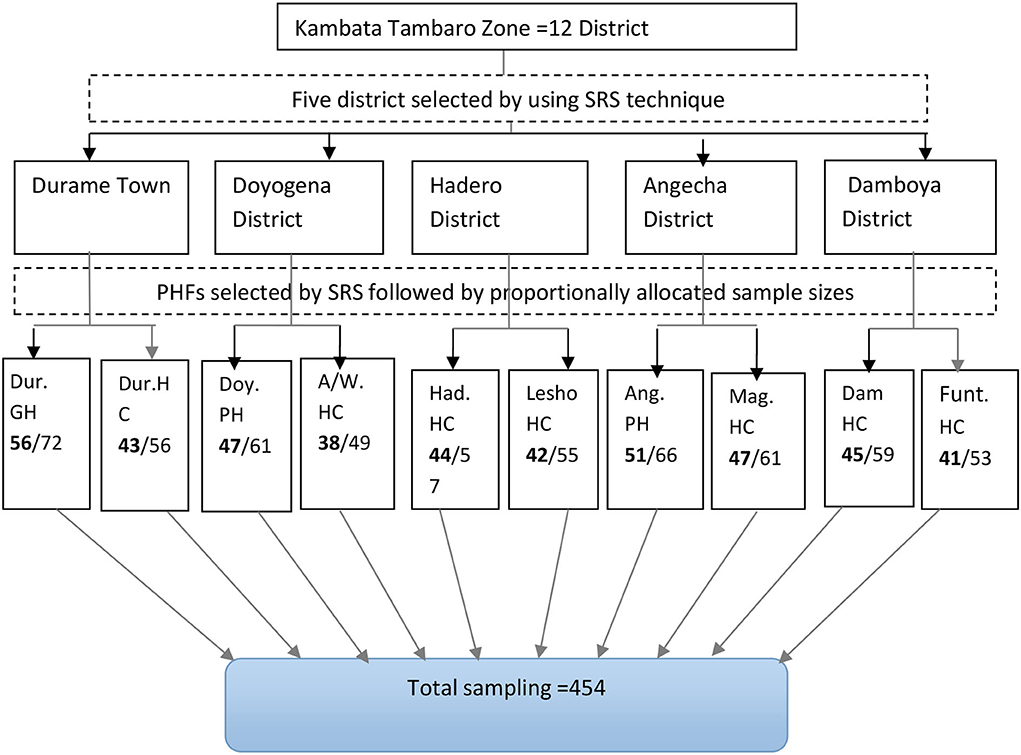
Figure 1. Schematic presentation of months of sampling procedure among Implanon users visiting public health facilities to discontinue Implanon in the Kambata Tambaro zone, 2020. GH, General hospital; HC, Health center; PH, Primary hospital; PHF, Public health facilities; SRS, Simple random sampling.
Data collection
A face-to-face interview was used to collect data using a pre-tested and structured questionnaire. The data collection tool was developed based on family planning indicators from the Ethiopian Demographic Health Survey 2016 and variables collected from different relevant literature works (15, 19, 20). It contains the sociodemographic background of women, the history of obstetrics, and the history of the use of contraceptive methods. The questionnaires were initially prepared in English and then translated into Amharic and Kambatisa and later backtranslated into English by language experts to check its consistency. Data collection was carried out by 8 female diploma midwives who were fluent speakers of the 2 languages (Amharic and Kambatisa). In addition two bachelor degree holder midwifery were recruited to supervise the data collection.
Variables
Dependent variable
Early Implanon discontinuation.
Independent variables
The sociodemographic character of the study participant, obstetric-related characteristics, and contraceptive method-related characteristics are independent variables.
Operational definition
Early Implanon discontinuation is defined as the removal of Implanon before completing 2.5 years since its insertion (8, 21). The date of insertion was taken from medical records and their appointment card. Then, the date is counted from insertion to discontinuation.
Data quality control
To ensure data quality, the questionnaires were pretested on 5% of the total sample size at Serera Health Center. The questionnaires were modified based on the pretest result, repetitive ideas and ambiguous questions were corrected, and the modified questionnaire was used for the final data collection. Data collectors and supervisors received two days of training on data collection and interview techniques. Proper categorization and coding of questionnaires were critically prepared before the data collection. Moreover, the supervisors and the principal investigator carefully checked the collected data daily for completeness, accuracy, and clarity.
Data processing and analysis
After data collection, the questionnaires were checked for its completeness, cleaned up, and coded. Then, data entry was performed using Epi Data version-3.1 and exported to STATA version-16 software for analysis. Simple frequencies and percentages were used to summarize data on the magnitude of early Implanon discontinuation. A bivariate logistic regression analysis was performed to examine the association between each independent variable and the outcome variable. Based on the findings, variables with a p < 0.2 in the bivariate logistic regression analysis were included in the multivariable logistic regression analysis. The adjusted odds ratio (AOR) along with the 95% confidence interval was estimated to assess the strength of the association. Variables with a p < 0.05 in the multivariable logistic regression analysis were considered as significant and independent predictors of early Implanon discontinuation. Hosmer and Lemeshow goodness-of-fit was used to assess whether the necessary assumptions were met. The model was considered to be well suited because it was not significant for the Hosmer–Lemeshow statistic (p = 0.610). A multicollinearity test was performed to see the correlation among the independent variables using collinearity statistics [variance inflation factor (VIF)], and no variables with a VIF >10 or a tolerance test < 0.1 were observed. Finally, the information was presented in the form of statements, tables, and graphs.
Ethical considerations
The present study was reviewed and approved by the Institutional Health Research Ethics Review Committee of the Colleges of Health and Medical Sciences, Haramaya University. The study participants were informed that their responses were kept confidential throughout the research process. For study participants who were less than 18 years, consent was obtained from their family or legal guardians. Data collection began after obtaining informed, voluntary written consent from each study participant.
Results
Sociodemographic characteristics of study participants
In the present study, 438 women visiting selected public health facilities in the zone were interviewed, resulting in a response rate of 96.48%. The age of the study participants ranged from 17 to 43 years, with the mean [±standard deviation (SD)] age of 26.88 ± 5.06 years. In addition, around 244 (55.7%) of the study participants lived in rural areas. Regarding educational status, 129 (29.5%) were women and 162 (38.8%) had husbands who had a college degree or higher. The result showed that half of the 222 (50.7%) study participants were housewives (Table 1).
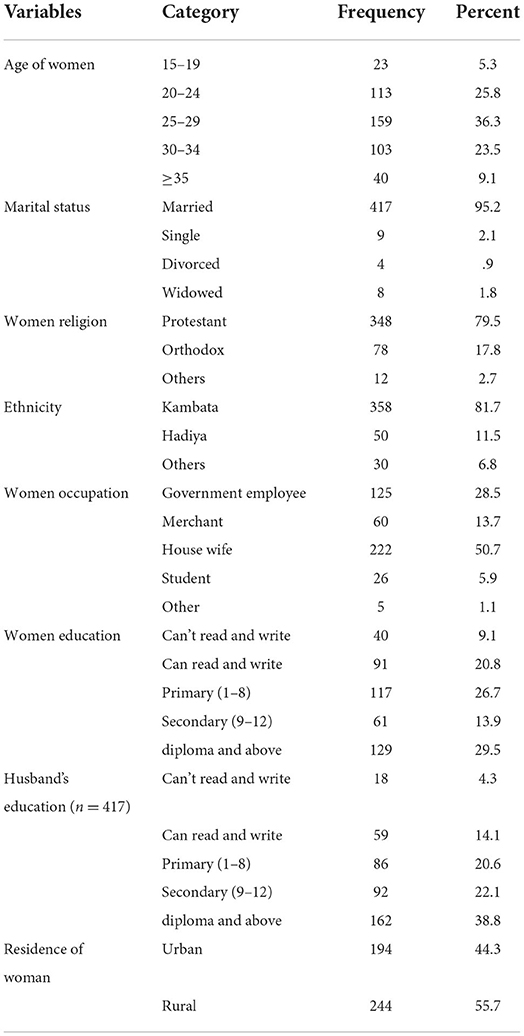
Table 1. Socio-demographic characteristics of Implanon user women visiting public health facilities to discontinue Implanon in Kembata Tambaro zone, South Ethiopia, 2020 (n = 438).
Obstetric-related characteristics
Regarding the parity of the study participants, 164 (37.4%) respondents had given birth three to four times. Around 325 (74.2%) of the women had at least one living child. In addition, 98 (22.4%) of the women had experienced a miscarriage in their previous pregnancy. Furthermore, 50% of the study participants had a desire to have a child soon, while 104 (47.1%) of them desire to have a child within 2 years (Table 2).
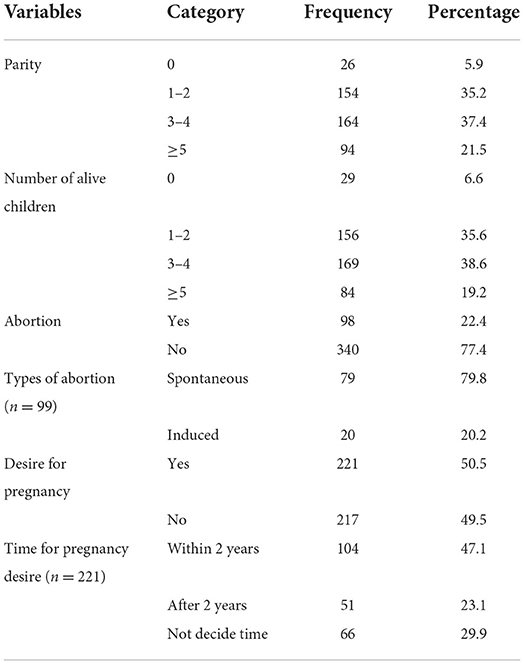
Table 2. Pregnancy and related characteristics of Implanon users women visiting public health facilities to discontinue Implanon in Kembata Tambaro zone, South Ethiopia, 2020 (n = 438).
Utilization of contraceptive methods and other related characteristics
Of the total study participants, 359 (82%) had used at least one modern contraceptive before undergoing current Implanon removal. The most commonly used modern contraception methods by these participants were injectable 231 (64.3%) and Pills 131 (36.5) before inserting Implanon. More than half (51.6%) of the participants received Implanon insertion services from the hospital, while 183 (41.8%) and 29 (6.6%) women received services from health centers and health posts, respectively. On the contrary, 380 (86.8%) participants indicated that they were counseled about the benefits and side effects of Implanon during the insertion period. In addition 353(80.5%) of women had support from their husband to use contraceptive. Furthermore, 326 (74.4%) of the study participants reported that they were satisfied with the service provided during Implanon insertion (Table 3).
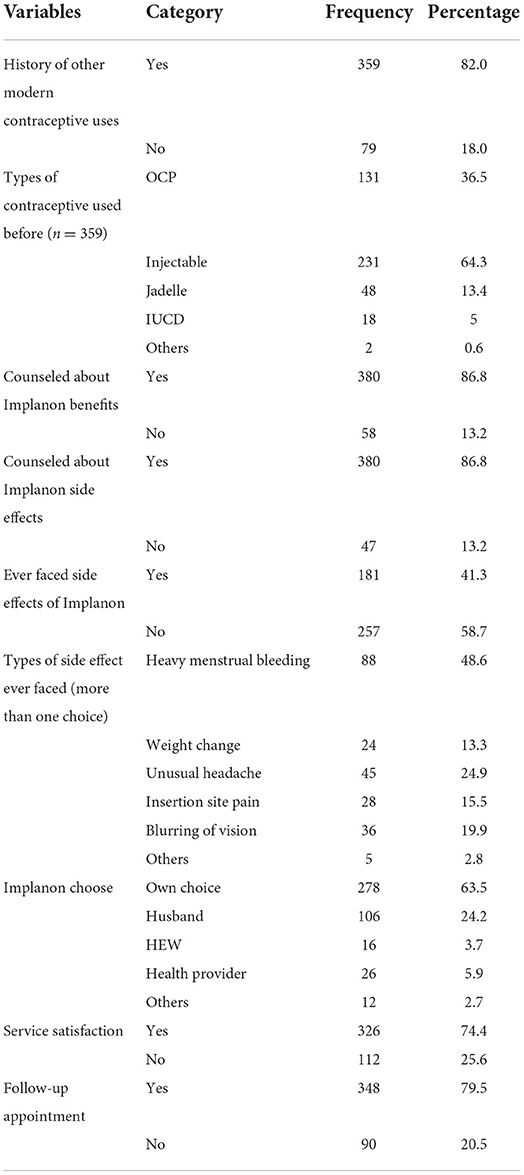
Table 3. Contraceptive method utilization and related characteristics among women visiting public health facilities to discontinue implanon in Kembata Tambaro Zone southern Ethiopia, 2020 (n = 438).
The magnitude of early Implanon discontinuation
In the present study, early Implanon discontinuation was reported by 247 women who discontinued Implanon at the public health facilities in the Kambata zone. This corresponds to a proportion of 56.4%, 95% CI (51.6–61.2), of which 6.8 and 23.3% discontinued before 6 and 12 months, respectively (Figure 2).
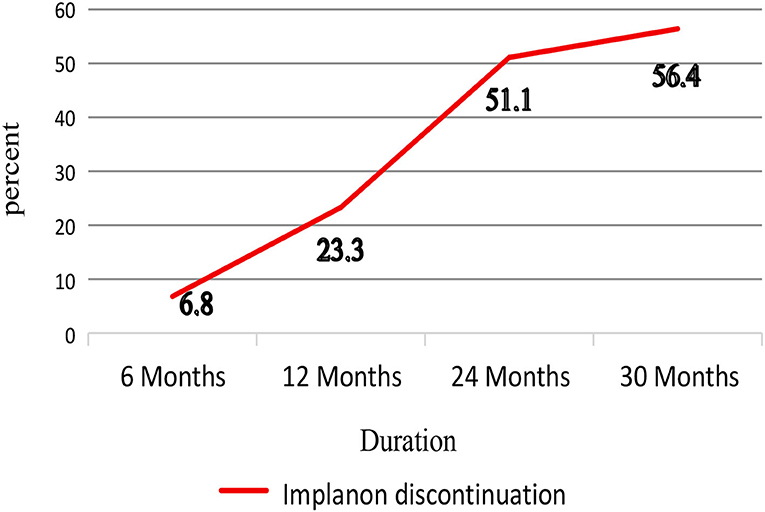
Figure 2. Magnitude of early Implanon discontinuation among implanon users women visiting public health facilities to discontinue Implanon in Kembata Tambaro zone, South Ethiopia, 2020 (n = 438).
Reasons for early Implanon discontinuation
In the study, 39.7% of the reasons stated for early Implanon discontinuation were becoming pregnant and having side effects due to Implanon and 36% for other reasons (death of husband, divorce, and method shift) (Figure 3).
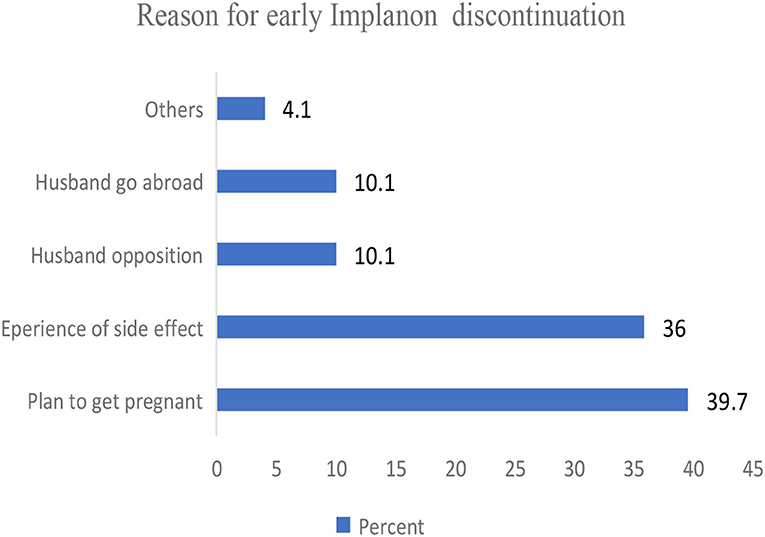
Figure 3. Reason for early Implanon discontinuation among Implanon users women visiting public health facilities to discontinue Implanon in Kembata Tambaro zone, south Ethiopia, 2020 (n = 438).
Factors associated with early Implanon discontinuation
The relationship between each independent variable and the outcome variable was analyzed separately. In the bivariate analysis, variables like women's education, the place of residence, history of abortion, husband's support, counseling on the side effects of Implanon, counseling on the benefits of Implanon, those who developed side effects, satisfaction with the service given, and follow-up appointments showed an association with early Implanon discontinuation at a p ≤ 0.2.
Multivariable logistic regression was performed to control for confounding variables and to identify factors associated with early Implanon discontinuation. Thus far, women living in rural areas (AOR = 1.76, 95% CI: 1.06–2.92), women having primary educational status [AOR = 2.92, 95% CI (1.56, 5.46)], woman who had no history of contraceptive use [AOR = 2.14, 95% CI (1.14, 4.03)], women who experienced side effects [AOR = 3.36, 95% CI (2.09, 5.42)], those who lack follow-up for a pre-insertion appointment [AOR = 2.17, 95% CI (1.18, 4.79)], and those dissatisfied with services [AOR = 3.05, 95% CI (1.52, 6.12)] were associated with early Implanon discontinuation at a p < 0.05 (Table 4).
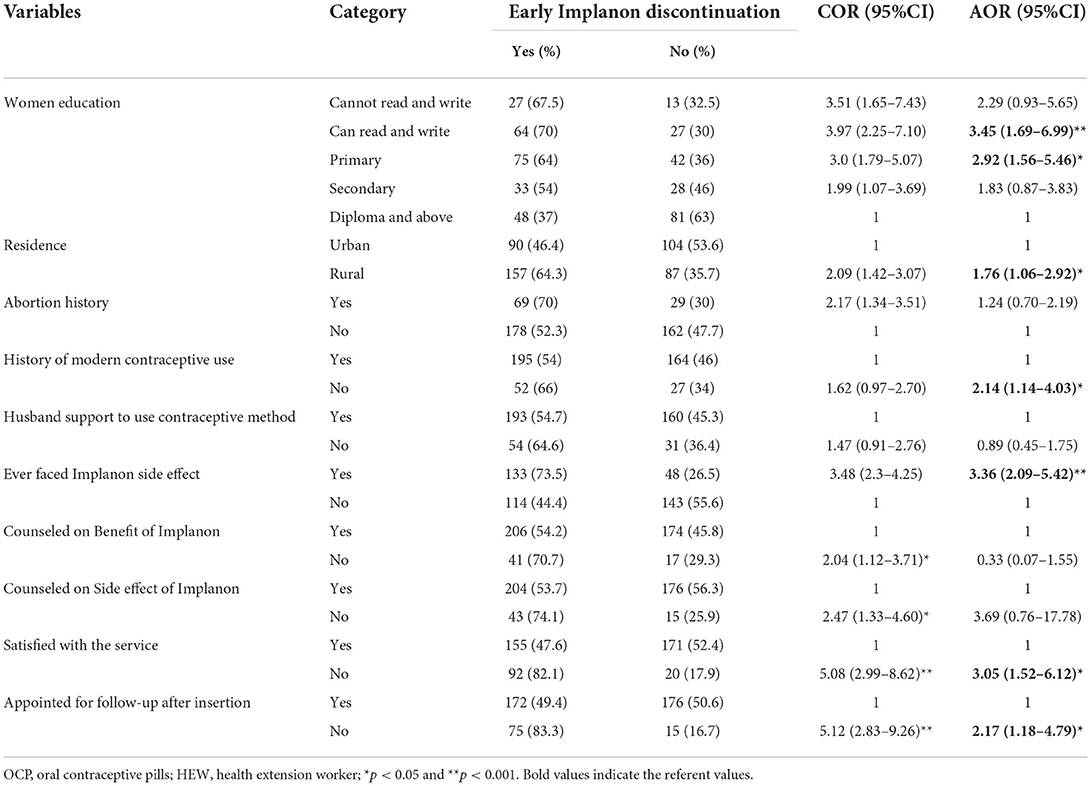
Table 4. Factors associated with Early Implanon discontinuation among implanon users women visiting public health facilities to discontinue Implanon in Kembata Tambaro zone, South Ethiopia, 2020 (n = 438).
Discussion
The current study attempts to determine the magnitude of early Implanon discontinuation and associated factors in the study area. Thus, the study indicated that early Implanon discontinuation is high in number. In addition, factors like educational status, place of residence, counseling on the side effects of Implanon, lack of follow-up appointment after the insertion of Implanon, and lack of satisfaction with the service provided were associated with early Implanon discontinuation.
The current study revealed that around 56.4% of women discontinued Implanon early. The result of the present study is consistent with the study conducted in Queensland, Australia, in which Implanon discontinuation was observed within 2.5 years (57.7%) (22). However, this finding is higher than that of studies conducted in India (37%), Yemen (43%), and central Ethiopia (46.3%) (23–25). In addition, the result of this study was lower than that of the studies conducted in the town of Debre Tabor and in the district of Andebet of north-western Ethiopia, which reported the magnitude of early Implanon discontinuation as 65 and 85%, respectively (19, 26). This discrepancy could be attributed to sociocultural and country differences in the coverage and quality of reproductive health services. Furthermore, because this study was institutional and some of the studies used for comparison were conducted at the community level, the disparity in sample size and study setting could account for this difference.
The findings from this study showed that the main reason of women who requested early Implanon discontinuation was suffering from side effects and their husband's resistance. This finding was also reported in the study conducted in the Andebet district in north-western Ethiopia (19). This could be due to inadequate pre-insertion counseling on the side effects of Implanon as the side effects of Implanon, such as menstrual disruption, can disrupt their daily activities and sexual relations with their spouse. Thus, involving the husband in the discussion during insertion is a good solution to maintain this contraceptive method until the removal due date.
However, this study found that women with primary educational status were 2.9 times more likely to discontinue Implanon early than women with college or higher educational status. The findings from the current study were found to be consistent with the findings from other studies conducted in Bangladesh, South Africa, Kenya, and Mekelle, which found that women with higher levels of education were less likely to discontinue Implanon before the due date (5, 16, 27, 28). One possible explanation might be that women with higher levels of education understand the benefits of contraceptives and their side effects better, which help them to handle and maintain Implanon.
In contrast, the present study showed that women who reside in rural areas were 1.76 times more likely to discontinue Implanon early compared to those who reside in urban areas. This is supported by a study conducted in Bangladesh, which reported that rural communities were more likely to discontinue Implanon than those living in urban communities (27). Women who live in rural areas are likely to lack access to information and use reproductive services as early as they would like, which may lead them to remove Implanon early due to mild side effects.
Moreover, this study found that women who had no history of modern contraceptive use before the current Implanon were 2.1 times more likely to discontinue Implanon early than those who had a history of contraceptive use. This could be because women who previously used contraceptive methods had a better understanding of how to cope with the side effects. The finding of the present study was supported by a study conducted in the Tigray Region, which revealed that women with a history of contraceptive use were 11 times less likely to discontinue Implanon compared to women with no history of contraceptive use (29).
Furthermore, the current study revealed that women who experienced the side effects of Implanon were 3.3 times more likely to discontinue Implanon early because the side effects of Implanon, such as menstrual disruption, can interfere with their daily activity and sexual life. This agrees is in line with studies conducted in India (23), the USA (30), Tigray (31), and the city of Hawasa (32). As a result, comprehensive counseling on the side effects of Implanon during Implanon insertion, with a focus on how to cope with the side effects, is beneficial in overcoming early Implanon discontinuation due to the side effects of Implanon (33).
To crown up, the findings of this study also showed that women who were not satisfied with the service provided during the insertion of Implanon were three times more likely to discontinue Implanon early than those who were satisfied. This could be due to a lack of privacy and improper pre-insertion counseling on expected side effects of Implanon, which can lead to women being dissatisfied with the service and contributing to early Implanon discontinuation. This finding is consistent with a study conducted in southern Ethiopia (18). Therefore, providing quality reproductive health services to clients can lead to better satisfaction and use of the services (34).
Conclusion
The magnitude of early Implanon discontinuation was high. Educational status, lack of a previous history of contraceptive method usage, women who experienced side effects, rural residents, those dissatisfied with the service provided, and a lack of follow-up appointments. Improving partner involvement in family planning services (decision-making) can increase the continuation rate of Implanon contraceptives among user women. Healthcare providers must focus on pre-insertion counseling on Implanon side effects, which is essential in tackling discontinuation related to Implanon side effects. In addition, early management of side effects and reassurance are essential to minimize early Implanon discontinuation. Furthermore, improving client service satisfaction and appointment follow-up also should be considered to escalate the proper use of Implanon.
Limitations and strengths of this study
In the present study, the magnitude of early Implanon discontinuation was assessed using an appropriate sample size. This study addressed cultural issues, including female data collection, as it is common in the community to discuss reproductive issues with the same gender. This may also reduce the social desirability bias. This study is based on one facility; it may not indicate the true early Implanon discontinuation in the community. A limitation of this study is that women without an appointment card may have had difficulty remembering the insertion date of Implanon (recall bias).
Data availability statement
The raw data supporting the conclusions of this article will be made available by the authors, without undue reservation.
Ethics statement
The studies involving human participants were reviewed and approved by Institutional Health Research Ethics Review Committee of the Colleges of Health and Medical Sciences, Haramaya University. Written informed consent to participate in this study was provided by the participants' legal guardian/next of kin.
Author contributions
GB was the principal investigator who initiated the research, participated in writing the proposal, formal conducted data analysis, and participated in writing the original draft of this manuscript. NA, TY, TM, and HBE provided general guidance for overall study progress and participated in proposal review, analysis review, and manuscript writing. All authors have read and approved the final manuscript and are accountable for all aspects of this work.
Funding
Doyogena primary hospital has provided financial support for this study. The authors declared that the funding body has no role in designing the study, data collection, data analysis, and writing the manuscript.
Acknowledgments
The authors thank the members of Haramaya University College of Health and Medical Sciences for their kind cooperation during this study. The authors would also like to express their gratitude to the Kambata Tambaro zone health bureau and study participants in the region for their genuine cooperation during data collection and throughout this study.
Conflict of interest
The authors declare that the research was conducted in the absence of any commercial or financial relationships that could be construed as a potential conflict of interest.
Publisher's note
All claims expressed in this article are solely those of the authors and do not necessarily represent those of their affiliated organizations, or those of the publisher, the editors and the reviewers. Any product that may be evaluated in this article, or claim that may be made by its manufacturer, is not guaranteed or endorsed by the publisher.
References
1. Ahmed S, Li Q, Liu L, Tsui AO. Maternal deaths averted by contraceptive use: an analysis of 172 countries. Lancet. (2012) 380:111–25. doi: 10.1016/S0140-6736(12)60478-4
2. Bhatia P, Nangia S, Aggarwal S, Tewari C. Implanon: subdermal single rod contraceptive implant. J Obstet Gynecol India. (2011) 61:422–5. doi: 10.1007/s13224-011-0066-z
3. Power J, French R, Cowan FM. Subdermal implantable contraceptives versus other forms of reversible contraceptives or other implants as effective methods for preventing pregnancy. Cochrane Database Syst Rev. (2007) 2007:CD001326. doi: 10.1002/14651858.CD001326.pub2
4. Rowlands S, Searle S. Contraceptive implants: current perspectives. Open Access J Contracept. (2014) 5:73–84. doi: 10.2147/OAJC.S55968
5. Jacobstein R. Liftoff: the blossoming of contraceptive implant use in Africa. Glob Health Sci Pract. (2018) 6:17–39. doi: 10.9745/GHSP-D-17-00396
6. Central Statistical Agency, ICF. Ethiopia Demographic and Health Survey. Addis Ababa: ICF (2016).
7. Ali MM, Cleland JG, Shah IH, World Health Organization. Causes and Consequences of Contraceptive Discontinuation: Evidence From 60 Demographic and Health Surveys. Geneva: World Health Organization (2012).
8. Tadesse A, Kondale M, Agedew E, Gebremeskel F, Boti N, Oumer B. Determinant of Implanon discontinuation among women who ever used Implanon in Diguna Fango District, Wolayita zone, southern Ethiopia: a community based case control study. Int J Reprod Med. (2017) 2017:2861207. doi: 10.1155/2017/2861207
9. Pam V, Mutihir J, Karshima J, Kahansim M, Musa J, Daru P. Factors associated with use and discontinuation of Implanon contraceptive in Jos, Nigeria. Trop J Obstetr Gynaecol. (2014) 31:90–9.
10. Curtis S, Evens E, Sambisa W. Contraceptive discontinuation and unintended pregnancy: an imperfect relationship. Int Perspect Sex Reproduct Health. (2011) 37:58–66. doi: 10.1363/3705811
11. Upadhyay UD, Brown BA, Sokoloff A, Raine TR. Contraceptive discontinuation and repeat unintended pregnancy within 1 year after an abortion. Contraception. (2012) 85:56–62. doi: 10.1016/j.contraception.2011.05.009
12. Bearak J, Popinchalk A, Alkema L, Sedgh G. Global, regional, and subregional trends in unintended pregnancy and its outcomes from 1990 to 2014: estimates from a Bayesian hierarchical model. Lancet Glob Health. (2018) 6:e380–9. doi: 10.1016/S2214-109X(18)30029-9
13. Do Nascimento Chofakian CB, Moreau C, Borges ALV, Dos Santos OA. Contraceptive discontinuation: frequency and associated factors among undergraduate women in Brazil. Reprod Health. (2019) 16:131. doi: 10.1186/s12978-019-0783-9
14. Birhane K, Hagos S, Fantahun M. Early discontinuation of implanon and its associated factors among women who ever used implanon in Ofla District, Tigray, Northern Ethiopia. Int J Pharma Sci Res. (2015) 6:544–51.
15. Akilimali P, Hernandez J, Anglewicz P, Kayembe KP, Bertrand J. Incidence and determinants of Implanon discontinuation: findings from a prospective cohort study in three health zones in Kinshasa, DRC. PLoS ONE. (2020) 15:e0232582. doi: 10.1371/journal.pone.0232582
16. Mrwebi KP, Ter Goon D, Owolabi EO, Adeniyi OV, Seekoe E, Ajayi AI. Reasons for discontinuation of Implanon among users in Buffalo City Metropolitan Municipality, South Africa: a cross-sectional study. Afr J Reprod Health. (2018) 22:113–9. doi: 10.29063/ajrh2018/v22i1.11
18. Nageso A, Gebretsadik A. Discontinuation rate of Implanon and its associated factors among women who ever used Implanon in Dale District, Southern Ethiopia. BMC Womens Health. (2018) 18:189. doi: 10.1186/s12905-018-0678-x
19. Dagnew GW, Gelaw YM, Asresie MB, Anteneh ZA. Level and Timing of Implanon Discontinuation and Associated Factors Among Women Who Used Implanon in Andabet District, Public Health Facilities, North-West Ethiopia, 2017. Hindawi; BioMed Research International (2019).
20. Belete N, Zemene A, Hagos H, Yekoye A. Prevalence and factors associated with modern contraceptive discontinuation among reproductive age group women, a community based cross-sectional study in Humera town, northern Ethiopia. BMC Womens Health. (2018) 18:190. doi: 10.1186/s12905-018-0663-4
21. Robinson T, Anita Register IV O, Ebner C, Orr K. Reducing early discontinuation rates of subdermal contraception in your clinical practice. Osteopath Fam Phys. (2015) 7:24–8.
22. Harvey C, Seib C, Lucke J. Continuation rates and reasons for removal among Implanon users accessing two family planning clinics in Queensland, Australia. Contraception. (2009) 80:527–32. doi: 10.1016/j.contraception.2009.05.132
23. Agrahari K, Mohanty SK, Chauhan RK. Socio-Economic differentials in contraceptive discontinuation in India. SAGE Open. (2016) 6:2158244016646612. doi: 10.1177/2158244016646612
24. Staveteig S, Mallick L, Winter R. Uptake and Discontinuation of Long-Acting Reversible Contraceptives (LARCs) in Low-Income Countries. Rockville, MD: ICF International (2015)
25. Kassa M, Melese S. Premature implanon discontinuation and associated factors among implanon user women in Ambo town, Central Ethiopia, 2018. J Health Med Nurs. (2019) 58:39–46. doi: 10.7176/JHMN/58-05
26. Melkamu Asaye M, Syoum Nigussie T, Mequannt Ambaw W. Early Implanon discontinuation and associated factors among Implanon user women in Debre Tabor town, public health facilities, Northwest Ethiopia, 2016. Int J Reprod Med. (2018) 2018:3597487. doi: 10.1155/2018/3597487
27. Mahumud RA, Hossain MG, Sarker AR, Islam MN, Hossain MR, Saw A, et al. Prevalence and associated factors of contraceptive discontinuation and switching among Bangladeshi married women of reproductive age. Open Access J Contracept. (2015) 6:13–9. doi: 10.2147/OAJC.S76070
28. Medhin T, Gebrekidan KG, Nerea MK, Gerezgiher H, Haftu M. Early Implanon discontinuation rate and its associated factors in health institutions of Mekelle City, Tigray, Ethiopia 2016/17. BMC Res Notes. (2019) 12:8. doi: 10.1186/s13104-018-3992-3
29. Gebre-Egziabher D, Araya Abrha Medhanyie, Alemayehuand M, Tesfay FH. Prevalence and predictors of implanon utilization among women of reproductive age group in Tigray Region, Northern Ethiopia. Reprod Health. (2017) 14:62. doi: 10.1186/s12978-017-0320-7
30. Diedrich JT, Zhao Q, Madden T, Secura GM, Peipert JF. Three-year continuation of reversible contraception. Am J Obstetr Gynecol. (2015) 213:662.e1–8. doi: 10.1016/j.ajog.2015.08.001
31. Kalayu B, Seifu Hagos, Fantahun M. Early discontinuation of implanon and its associated factors among women who ever used implanon in Ofla District, Tigray, Northern Ethiopia. Int J Pharma Sci Res. (2015)6:544–51.
32. Tesfaye K. Early discontinuation of implant and its associated factors among women who ever used Implant in 2017/2018 in Hawassa Health Centers, Southern Ethiopia, 2019. J Med Care Res Rev. (2019) 2:320–30.
33. Mansour D, Korver T, Marintcheva-Petrova M, Fraser IS. The effects of Implanon® on menstrual bleeding patterns. Euro J Contracept Reprod Health Care. (2008) 13:13–28. doi: 10.1080/13625180801959931
Keywords: Implanon, discontinuation, women, Ethiopia, early
Citation: Beyene GN, Assefa N, Mokonnon TM, Ejigu HB and Yadeta TA (2022) Early Implanon discontinuation and associated factors among Implanon women users visiting public health facilities, in Kembata zone of Southern Ethiopia: An institution based cross-sectional study. Front. Glob. Womens Health 3:909411. doi: 10.3389/fgwh.2022.909411
Received: 01 April 2022; Accepted: 17 June 2022;
Published: 11 August 2022.
Edited by:
Wubet Bayih, Debre Tabor University, EthiopiaReviewed by:
Ephrem Yohannes, Ambo University, EthiopiaGemechu Gelan Bekele, Ambo University, Ethiopia
Copyright © 2022 Beyene, Assefa, Mokonnon, Ejigu and Yadeta. This is an open-access article distributed under the terms of the Creative Commons Attribution License (CC BY). The use, distribution or reproduction in other forums is permitted, provided the original author(s) and the copyright owner(s) are credited and that the original publication in this journal is cited, in accordance with accepted academic practice. No use, distribution or reproduction is permitted which does not comply with these terms.
*Correspondence: Habtamu Bekele Ejigu, aGFidGkuYmVrZWxlQGdtYWlsLmNvbQ==
†ORCID: Nega Assefa orcid.org/0000-0003-0341-2329
Habtamu Bekele Ejigu orcid.org/0000-0001-9839-1908
Tesfaye Assebe Yadeta orcid.org/0000-0003-3015-8979
 Gemechu Nigusie Beyene1
Gemechu Nigusie Beyene1 Nega Assefa
Nega Assefa Habtamu Bekele Ejigu
Habtamu Bekele Ejigu Tesfaye Assebe Yadeta
Tesfaye Assebe Yadeta